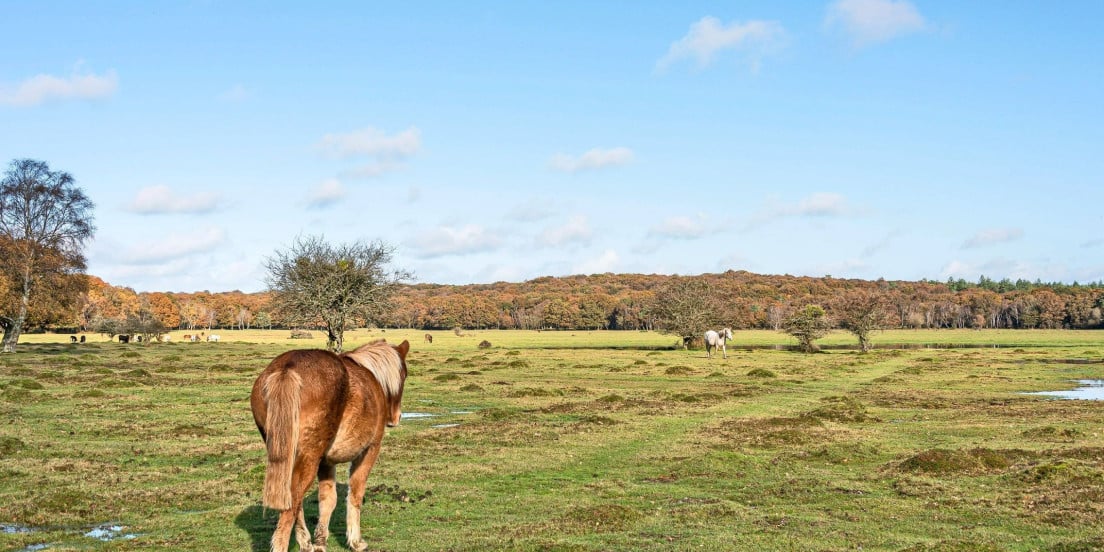New Forest, new home?
11 May 2020
Posted under: News articles


The New Forest is anything but new. Two hours away from London, it is one of the largest remaining areas of unenclosed pastureland and heathland. The New Forest was proclaimed a royal forest in 1079 by William the Conqueror, earning itself a place in the Domesday Book.
Crowned a National Park in 2005, the combined charms of the forest make it a joy to explore, with the web of walkways and cycle paths connecting the villages dotted around the landscape. The three largest villages of Brockenhurst, Lyndhurst and Burley are home to some of the south’s greatest wildlife and are full of character. The famous New Forest ponies graze nonchalantly by the roadsides and amble through the villages, with donkeys, deer, and even pigs making an appearance. The forest has captured the hearts of so many people throughout history, including Florence Nightingale, and will most definitely capture yours.
Things to do
Whatever the season, there is always something available to explore and experience in the New Forest. From a simple stroll through the trees to a long-distance hike through the towns and villages following the beautiful coastline, it is home to an extensive network of footpaths. There are also guided walk companies on hand, ready to help you fully explore the charms of the forest.
Cyclists will also feel at home here, with the opportunity to go off-road on over 100 miles of tracks.
The Forest is also known for its famous attractions including the family friendly Peppa Pig World at Paulton’s Park and the internationally renowned National Motor Museum at Beaulieu. Whereas, for anyone who enjoys learning about animals and wildlife, the New Forest Wildlife Park and Marwell Zoo make great places to visit.
I spy with my little eye…
As a National Park, the New Forest is packed with diverse habitats and many kinds of wildlife. Much of the park has been awarded Special Area of Conservation status, with many creatures found within the hundreds of miles of bogs, woodlands and open heathland. With such a variety of species, the wildlife is undoubtedly one of its main attractions.
The New Forest is synonymous with its native ponies, which can be seen freely roaming and grazing the land, not just out in the open countryside, but also in the towns and villages. They come in several different colours and sizes, as over the centuries they have been crossbred with other breeds to increase variety. Donkeys can also be seen in the New Forest year-round, as they have a hardy nature that makes them more tolerant of the winter weather conditions. Popular with visitors, they love to graze on hedgerows, and are therefore more likely to be seen in towns.
The New Forest is home to five different species of deer, though they are less visible now that some of the faster roads are fenced. Several species, however, do still roam the woods, including the tiny Sika deer, descendants of a pair that escaped from nearby Beaulieu in 1904.
The New Forest is the only remaining place in the UK where you can witness the ancient practice of pannage, where pigs are released into the woods to forage for acorns, beechmast and chestnuts. Not only does this result in Britain’s own Ibérico-style ham, it also protects the forest’s free-roaming ponies and cattle, as acorns would be poisonous to them if they ate them in large quantities.
Refuel and refresh
The New Forest is also home to a huge range of pubs and tearooms, which give the forest a unique sense of comfort and a quintessentially English feel. From award-winning dining at The Montagu Arms, through to five-star dining at Chewton Glen, there are options to provide you with a truly memorable experience. If pub food isn’t your thing, there are plenty of tearooms scattered throughout the towns and villages which make for an amazing brunch or afternoon tea – any of which would be a great place to stop and refuel after a day of exploring.
---
It’s not only the wildlife that can call the New Forest home, you could live here too with PegasusLife’s beautiful collection of homes in Brockenhurst available to buy. To find out more, contact 01590 615288 or [email protected].